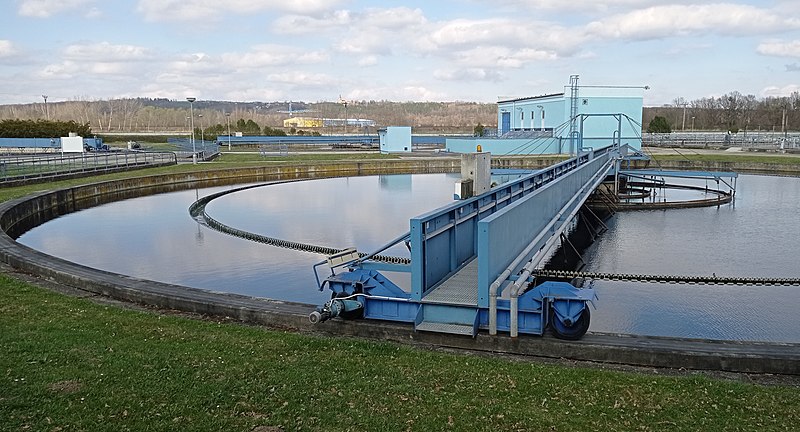
Water Treatment Plant, Czeva, CC BY-SA 4.0 <https://creativecommons.org/licenses/by-sa/4.0>, via Wikimedia Commons
Setting the rates for wastewater services is an exercise that should be done when the annual budget is prepared. The rates need to generate sufficient revenue to cover operation and maintenance (O&M), repair and replacement (R&R), principal and interest payments for debt service, depreciation, and reserves. The rate set for services is generally a monthly charge that includes a set amount to cover fixed expenses and a volume use charge to cover variable expenses.
Budget Considerations
The operation and maintenance expenses for a wastewater system typically address the collection system of sewers and lift stations and the wastewater treatment works. The major O&M expense line items include salaries, fringe benefits for employees, utilities, chemicals and supplies. It should also include supplies needed for planned and, to the best extent possible, unplanned maintenance. The repair and replacement line item is ideally from the existing Asset Management Plan (AMP). Introduction to Asset Management If an AMP has not been completed, the Capital Improvement Plan is the next best resource, but it may not include planned repairs, only planned replacements. Therefore, it may take further internal discussions to determine this number. The debt service includes the costs of any annual principal and the interest payments for any debt the system has taken on. Many times, the interest payments are listed as a line item in the operation and maintenance budget. Instead the principal payments may be included as a balance sheet expense. In such a case it is necessary to be sure the depreciation expense line item is sufficient to cover debt service principal payments. Some budgets will include the annual repair and replacement expense within the depreciation line item expense as well. If depreciation is used as a catch all for any anticipated expenses a supplemental budget with a break down of what is included in the depreciation line item is in order.
If the annual repair and replacement expense line item includes the annual cost associated with the items listed in the Asset Management Plan, it is possible that not every item listed is going to have an actual expense in every budget year. Therefore, at the end of the budget year the unexpended balance in the repair and replacement line item should be transferred to a Repair and Replacement Reserve Fund. When the budgeted annual repair and replacement line item does not have a sufficient balance to pay for a necessary R&R expense then the R&R Reserve Fund Balance may be used to fund the expense.
Reserves need to be recognized as an annual expense. Debt service documents may require a set amount of money to be set a side each year in a reserve for debt service payments. The annual reserve amount required is generally some percent of the annual debt service payment. This amount of reserve would typically be required to be set aside each year until one full annual payment of principal and interest for the bond issue is accumulated in the debt service reserve fund. If there are multiple bond issues there may be multiple reserve fund requirements. Other annual reserve line items may include amounts to be set aside for emergencies, contingencies, or to fund a surplus. The separate Reserve Fund balances need to be maintained and used for their specific purpose.
The annual budget is adopted by the appropriate governing body and the necessary fixed charge and volume of use charge are set as a part of the budget process. The governing body is generally very interested in the affordability Measuring and Addressing Water and Waste Water Affordability in the U.S. of the wastewater rates. The typical residential user of a wastewater system uses 4000 gallons per month of water and thus the assumption is it generates around 4000 gallons of wastewater. It is this charge that most governing bodies are interested in and is a determining factor in affordability considerations.
Affordability of Water
EPA’s metric for water affordability is the most widely used metric for household wastewater expense and is set at two percent of a household’s income. The combined EPA metric for an unaffordable rate for wastewater and water is 4.5%. The USDA Rural Development agency recognizes any wastewater or water expense in excess of 1.5 percent of the Median Household Income (MHI) as being excessive. The MHI is a number generated by US Census data generally for a particular unit of government such as City, Village, Township, County, Metropolitan area, or State. The MHI number can be further broken down by census tract. However, the MHI number does not reflect individual household affordability. Affordability for a household reflects socio – economic factors, such as unemployment, low income households, households below the poverty level, and households receiving public assistance. Many of these factors are contained in the US Census data. Consumer water use and delinquency rates for wastewater customers are generally available from the unit of government providing the wastewater service.
Customer Assistance Programs (CAP) can be designed for a community by looking at data for poverty and low-income households, as well as late and delinquent bill payment rates. The source of money to cover the costs of CAP subsidy needs to be determined and addressed. Two typical sources are the wastewater system charges levied on the other customers and a transfer of funds from the community General Fund. The General Fund revenues are various taxes, shared revenue from external sources, and other charges for service. A portion of tax revenue earmarked for the subsidy of the CAP is one way to cover the associated cost.
Other references:
https://efcnetwork.org/tools-publications/video-full-cost-pricing-of-water/

